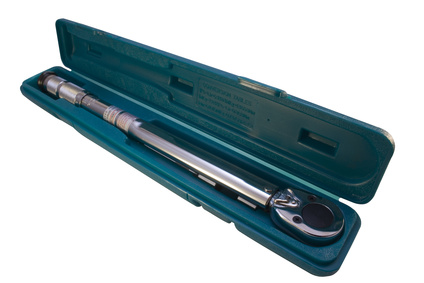
Torque wrenches are indispensible when a bolt or screw must have a specific tightness but not be over tightened. It is a tremendous help to know that the chances of stripping a bolt are drastically reduced when using a torque wrench correctly. While they are not always exactly accurate, since they cannot measure bolt tension or the amount of stretch in a bolt before failure, they do give close approximations and are far superior to guessing, when bolt tightness matters. The other reason they may be off slightly is that they need minor recalibration.
Check wrench accuracy on the calibration machine by both widely accepted standards, the ASME B107.14 Hand Torque Tools (American Society of Mechanical Engineers) and ISO 6789 Hand Torque Tools Requirements and Test Methods (International Organization for Standardization). Complete both tests, since they are slightly different.
Test ASME method first at 100 percent by setting the wrench at 100 percent and operating it three times on the calibration tester. Reset the wrench to 20 percent and repeat the procedure; then, at 60 perecent, and finally back to 100 percent. Note the accuracy discrepancy with each of the three tests.

Complete the ISO version of this accuracy test, with the only difference being that you perform the same sequence at the same settings five times per setting instead of three times. If the readings are within five or six percent of the accuracy requirements, do not recalibrate. If they are beyond this accuracy parameter, recalibrate sufficiently to bring them back into accuracy range.
Recalibrate for minor adjustment by setting the wrench knob at 20 percent of full scale. Use a small flathead screwdriver to pry off the end cap/plug, and remove the plug from the end of the knob. Test the wrench again at the 20 percent level, turning the handle clockwise to increase or counter clockwise to decrease the reading to correct/adjust it.
Insert the T-shaped hex into the T-shaped slot on the wrench knob and loosen the set screw enough to let you work with the knob. Pull the knob out slightly and turn it to set the 0 at the 20 percent mark on the scale. The 0 and the 20 percent mark should be exactly aligned; then tighten the set screw back down.
Remove the scale bezel on the handle of the wrench using a 1/16 hex. Use your finger tip to manually reset the scale to the lowest increment line even with the lowest increment. Re-install the bezel and check the readings at the test settings of 20, 60 and 100 percent. Place a new replacement plug into the end of the wrench.
